"Nokia CEO, Olli-Pekka Kallasvuo, highlighted Nokia's focus on user experience, stating: "In 2010, we will drive user experience improvements, and the progress we make will take the Symbian user interface to a new level. As an operating system, Symbian has reach and flexibility like no other platform, and we have measures in place to push smartphones down to new price points globally, while growing margins."
Highlights from the targets and forecasts:
- Nokia expects industry mobile device volumes to be up approximately 10% in 2010, compared to 2009.
- Nokia targets its mobile device volume market share to be flat in 2010, compared to 2009.
- Nokia targets to increase its mobile device value market share slightly in 2010, compared to 2009.
- Nokia continues to target Services net sales of EUR 2 billion or more in 2011.
- Nokia continues to target to have 300 million active users for its services by the end of 2011.
In addition to providing its key targets, Nokia also outlined key 'Devices & Services' operational priorities for 2010. These are:
- Improve our user experience
- Re-engineer our Symbian user interface; deliver a major product milestone before mid-year 2010, and another major product milestone before the end of 2010
- Deliver our first Maemo 6-powered mobile computer, with an iconic user experience, in the second half of 2010
- Significantly increase the proportion of touch and/or QWERTY devices in our smartphone portfolio
- Scale up our Services business by expanding geographically and in partnership with more operators
- Provide third party developers with better tools to create applications and content for our Ovi ecosystem
- Continue to build on our affordable and localized services offerings for emerging market consumers"
Read more in the full Nokia press release
Rafe's comments
Nokia are making it clear that, in 2010 and going forward, a key theme will be the improvement of user experience. Key drivers in this realm are a continuing evolution of the Symbian platform and the introduction of Maemo 6.
Nokia will re-engineer its Symbian user interface. The big user experience changes will come with Symbian^4, which sees a Qt based Orbit and Direct UI combination replacing AVKON. Symbian^4 and the new UI is likely to get its first demo in the second half of the year, but will likely only be on shipping devices in the first part of 2011.
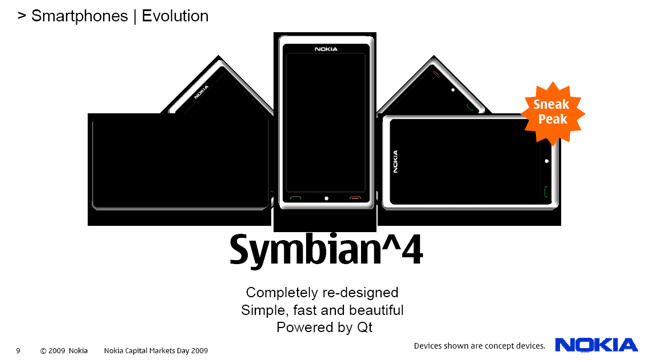
However we can also expect to see step changes with the release of Symbian^2 (now) Symbian^3 (in the summer). With Symbian^2 we will see N97 mini like experiences (widgets) and some additional elements, such as location triggering, to a broad range of Symbian phones, in multiple form factor and input configurations, in the first half of the year.
Symbian^3, which we will see in devices in 2010, will add multiple home screens, consistent one-tap navigation, and multi-touch gestures (limited support) in the user experience domain. Additionally NFC support, better data networking / bearer management, graphics acceleration in UI, CalDAV, remote Contacts, HDMI out, improved Bluetooth (e.g. AVRCP 1.4) and initial support for the Qt application framework (allowing for forwardly compatible applications) will also be included and, in part, impact on user experience.
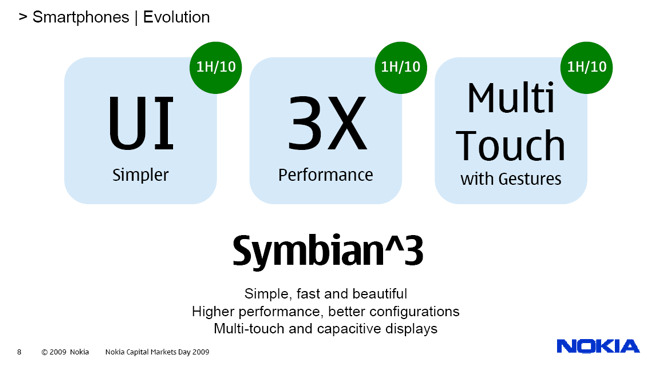
At Capital Markets Day Nokia pointed out some real world advantages noting that Symbian^3 would be three times as fast as previous versions (e.g. scrolling at 60 frames per second versus 15 frames per second) and that Symbian^3 sees the removal of some 300+ user prompts (are you sure want to...).
Nokia are making a clear commitment to deliver the first Maemo 6 device in 2010. This represents step 5 of 5 for Nokia's Maemo project and looks set to be the first truly 'consumer ready' Maemo based solution. I'm expecting a great deal of refinement to both the software and the hardware, although the mobile computing led approach remains the core value. Maemo 6 is the first version to have its application and UI framework built on top of Qt, which will bring a greater level of commonality between Maemo and Symbian for third party developers, especially with the introduction of Symbian^4.
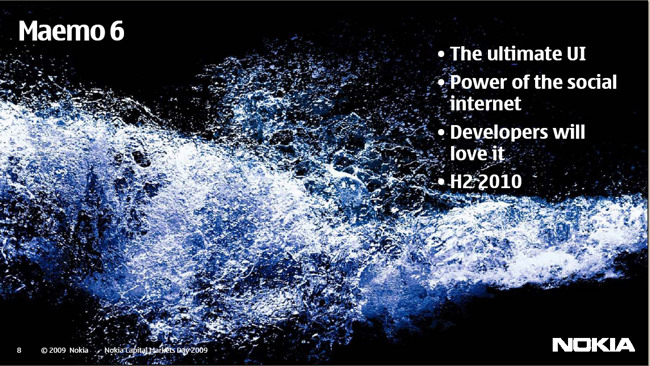
What's also clear is that Symbian and Maemo are Nokia's key platforms going forward. Symbian will become Nokia's primary platform (by device net sales). Maemo will focus on a high end mobiule computing led segment where Nokia expects to see significant growth. However Series 40 will still play an important role in connecting the next billion people.
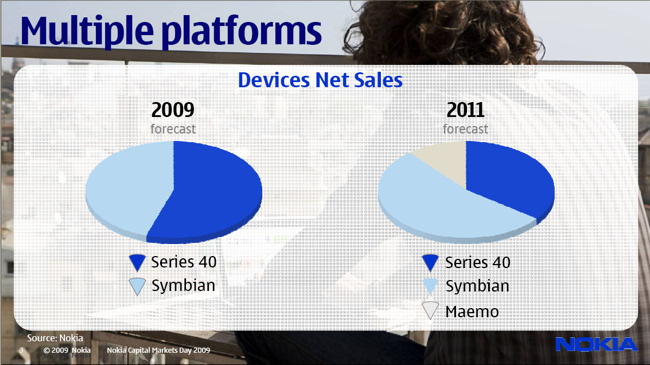

Slides from Nokia Capital Markets Day
The Capital Markets Day press release refers to two major product milestones. This aligns with the upcoming release of Symbian. We can expect to see a greater number of touch and/or QWERTY devices in the smartphone portfolio. It seems likely that this means we will see the first touch devices in the Eseries segment in 2010 and a continuation of the QWERTY across Nokia's device portfolio trend that has been prevalent in 2009. We will see an increasing number of hybrid devices (QWERTY and touch).
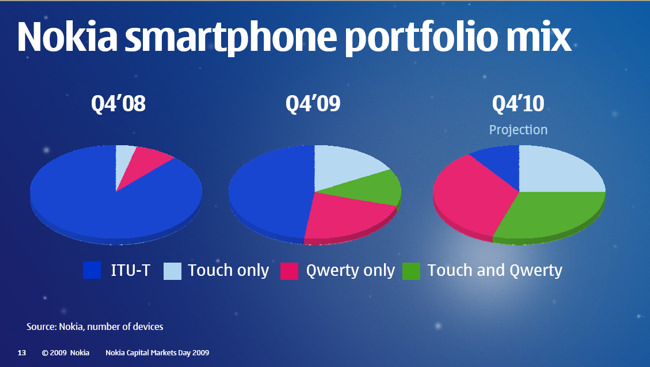
Slide from Nokia Capital Markets Day
Nokia's commitment to services remains a key business-building area (EUR 2 billion) with projected increases in the number of Ovi service users (now 70 million - to 300 million over the next 26 months). Service availability will expand geographically as Nokia signs up additional operator partners.
Ewan's Comments
I think it's time to put on the Columbo hat here, because this press release is pretty rich with detail and plans for next year and beyond. Forget the cuddly presentations and CGI videos, this is the meat. As with any press release, the key takeaway should be in the first paragraph. Here it is:
“Senior company executives outlined how Nokia's focus on execution combined with its core competitive advantages, position the company to achieve and sustain broad-based success in the mobile devices market. “
So Nokia are going to look at how they deliver something – well that's the same of any company, but “core competitive advantages” is a tricky one. In part this is saying we can keep being a success because we're already a success. There is an obvious danger there, but by stating their plans ahead of time in such a public way we can at least see they know where the problems are.
Symbian is still the OS of choice - currently powering the high-end smartphones but now having a strong share in the midrange, Nokia have publicly stated the S60 user interface needs a radical change. Significant improvements were on display - watch this space for more on this.
Why is Symbian OS so vital? Well apart from the UI, the underlying code is strong and bulletproof if handled correctly – something Nokia should have experience in, although recent firmware issues do make you wonder. The sheer depth and volume of the Symbian platform in the mid-range is going to provide a numerically attractive range... but there will still be fracturing, be it on a model basis, regional basis, individual networks and in how you can reach out to the consumers as much as developers. It's good to say “the numbers are there” (because that is a competitive advantage!) but it's how Nokia evangelise this to bring the developers to Ovi Store that is key.
While no specific models were announced, two major “product milestones” are to be delivered on Symbian during 2010, one at the end of Q2, and one at the end of Q4. These are not necessarily going to be handsets, but the timing of mid 2010 would be about right for a new “hero” device carrying the updates S60 UI, and will likely be a Symbian ^3 product. As to the second device, that could well be something debuting at Nokia World for availability in 2011.
Maemo 6's first device is also due in the second half of 2010 – it's doubtful that everyone online will pick up on this as evidence that the two OS will complement each other - they'll find something more nefarious between the lines.
Is all of this the right strategy for Nokia? Obviously they think so, and laying it out clearly not only helps communicate their thinking and mindset to the world, but also provides a yardstick for sites such as ourself to measure their progress. Whether it's the right strategy or the right goals, well that's one for discussion.
